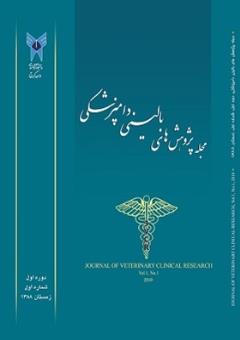Evaluation of healing effects of Leoheal spray(Allantoin, Boric acid, CH and Carbomer) on rats with full thickness excisional wound
Subject Areas : clinical veterinary science
Amin Nikpasand
1
*
![]() ,
seyede fatemeh Azariyan
2
,
Majid Mohammadsadegh
3
,
seyede fatemeh Azariyan
2
,
Majid Mohammadsadegh
3
1 - Department of clinical sciences, Karaj branch, Islamic Azad University, Karaj, Iran
2 -
3 - Department of clinical sciences, Garmsar branch, Islamic Azad University, Garmsar, Iran
Keywords: Leoheal spray, allantoin, wound healing, carbomer, boric acid,
Abstract :
Wound healing is a dynamic and complex process that includes 4 phases of hemostasis, inflammation, proliferation and matrix remodeling and is supported by a large number of cellular events. Leoheal spray contains the active ingrediants of allantoin, carbomer, boric acid and chlorhexidine. According to the severity and extent of the wound, the duration of treatment and treatment methods will be different. The use of topical ointments, new dressings and biological coatings are used to treat the wound. One of the other ways to repair wounds is to use chemical compounds that are effective in repairing skin layers. The combination of these materials with a synergistic effect in performance can also be effective in repairing it according to the nature of the damage. The purpose of this research to study the effectiveness of leoheal spray on the quality of wound healing process. This study was conducted on 20 male rats with an average weight of 250 to 300 grams. Rats were divided in two groups of without drug and positive control, and according to Abramov's indices, the effectiveness of drug on wound healing was evaluated using Shapro and Yelk statistical tests. The results of the statistical analysis showed that our desired indicators collagen deposition, neovascularization, fibroblast maturation, acute and chronic inflammation and the formation of granulation tissue in the two groups had no significant difference and only in the process of re epithelization followed a positive trend. (P=0.4). Leoheal spray leads to the improvement of re epithelization process in resection wounds.
1. Chaharsughi A, Ahmadi Dastgerdi A, Gholami-Ahangaran M. Antibacterial effect of Capparis spinosa (Capparis spinosa) and Pistacia atlantica (Pistacia atlantica) extracts on growth of Escherichia coli in vitro and in vivo. Veterinary Clinical Pathology. 2020;14(54).
2. Ansari M, Alizadeh AM, Paknejad M, Khaniki M, Naeimi SM. Effects of teucrium polium honey on burn wound healing process. Journal of Babol University of Medical Sciences. 2009 Aug 10;11(3):7-12.
3. Hadagali MD, Chua LS. The anti-inflammatory and wound healing properties of honey. European Food Research and Technology. 2014 Dec;239:1003-14.
4. RIAHI S, IMANI H, Torkamaan G, MOFID M, Ghoshouni H, Khoushbaten A. Effect of topical application of honey on skin wound healing with full thickness in male rats. 2008;5(1):23-27.
5. Salahvarzan A, Abdolahpour F, Ismaeili A, Sepahvand F. Anti-oxidant and anti-microbial activities of two types of honey by change in bees, diet in comparison with other honey productis in Abestan region of Khorramabad province. yafte. 2015;17(3): 10-15.
6. Reinke J, Sorg H. Wound repair and regeneration. European Surgical Research. 2012;49(1):35-43.
7. . Robson MC, Steed DL, Franz MG. Wound healing: biologic features and approaches to maximize healing trajectories. Current problems in surgery. 2001;38(2):72-140.
8. Hamp SE, Rosling B, Lindhe J. Effect of chlorhexidine on gingival wound healing in the dog. A histometric study. J Clin Periodontol 1975; 2(3):143-52.
9. Sanchez IR, Swaim SF, Nusbaum KE, Hale AS, Henderson RA, McGuire JA. Effects of chlorhexidine diacetate and povidone-iodine on wound healing in dogs. Vet Surg 1988; 17(6): 291
10. Abramov Y, Golden B, Sullivan M, Botros SM, Miller JJ, Alshahrour A, Goldberg RP, Sand PK. Histologic characterization of vaginal vs. abdominal surgical wound healing in a rabbit model. Wound repair and regeneration. 2007 Jan;15(1):80-6.
11. Valle KZ, Saucedo Acuña RA, Ríos Arana JV, Lobo N, Rodriguez C, Cuevas-Gonzalez JC, Tovar-Carrillo KL. Natural film based on pectin and allantoin for wound healing: obtaining, characterization, and rat model. BioMed Research International. 2020;2020(1):6897497.
12. Yaşayan G, Karaca G, Akgüner ZP, Bal Öztürk A. Chitosan/collagen composite films as wound dressings encapsulating allantoin and lidocaine hydrochloride. International Journal of Polymeric Materials and Polymeric Biomaterials. 2021 Jun 13;70(9):623-35.
13. Durmus AS, Yaman M, Can HN. Effects of extractum cepae, heparin, allantoin gel and silver sulfadiazine on burn wound healing: an experimental study in a rat model. 2012; 57(6):287-292.
14. Tepedelen BE, Soya E, Korkmaz M. Boric acid reduces the formation of DNA double strand breaks and accelerates wound healing process. Biological trace element research. 2016 Dec;174:309-18.
15. Hayati F, Ghamsari SM, Dehghan MM, Oryan A. Effects of carbomer 940 hydrogel on burn wounds: an in vitro and in vivo study. Journal of Dermatological Treatment. 2018 Aug 18;29(6):593-9.
16. Hui Q, Zhang L, Yang X, Yu B, Huang Z, Pang S, Zhou Q, Yang R, Li W, Hu L, Li X. Higher biostability of rh-aFGF-carbomer 940 hydrogel and its effect on wound healing in a diabetic rat model. ACS Biomaterials Science & Engineering. 2018 Apr 2;4(5):1661-8.
17. Abdel-Sayed P, Tornay D, Hirt-Burri N, de Buys Roessingh A, Raffoul W, Applegate LA. Implications of chlorhexidine use in burn units for wound healing. Burns. 2020 Aug 1;46(5):1150-6.

